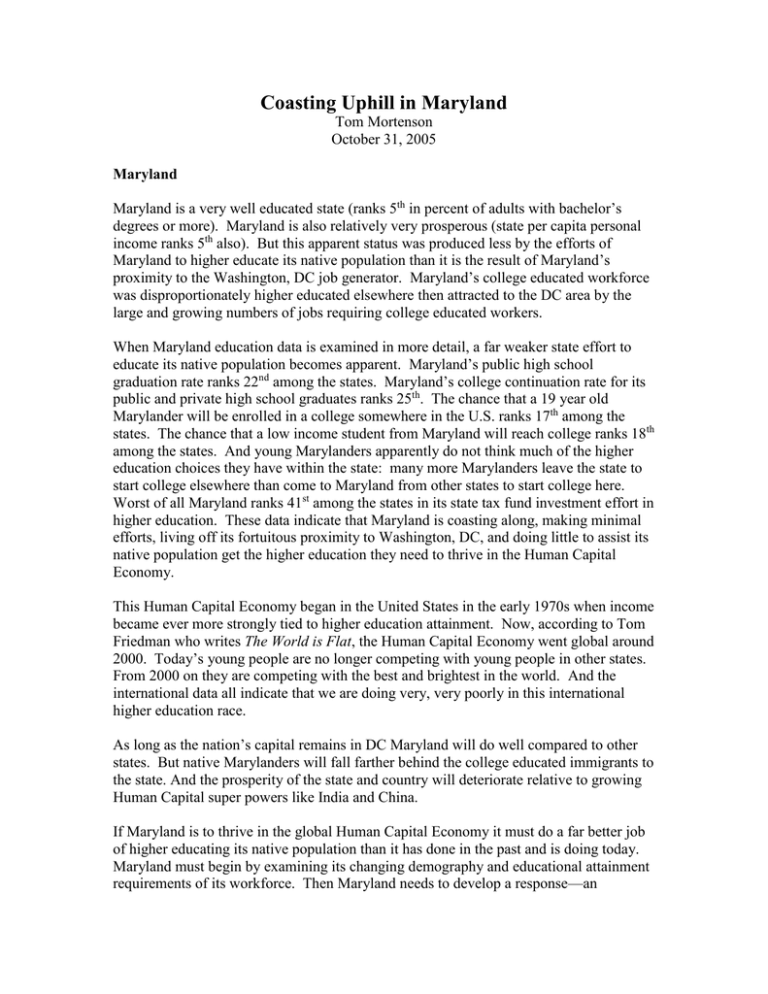Keynote Address: Coasting Uphill in the Global Human Capital Economy Thomas Mortenson
advertisement

Coasting Uphill in Maryland Tom Mortenson October 31, 2005 Maryland Maryland is a very well educated state (ranks 5th in percent of adults with bachelor’s degrees or more). Maryland is also relatively very prosperous (state per capita personal income ranks 5th also). But this apparent status was produced less by the efforts of Maryland to higher educate its native population than it is the result of Maryland’s proximity to the Washington, DC job generator. Maryland’s college educated workforce was disproportionately higher educated elsewhere then attracted to the DC area by the large and growing numbers of jobs requiring college educated workers. When Maryland education data is examined in more detail, a far weaker state effort to educate its native population becomes apparent. Maryland’s public high school graduation rate ranks 22nd among the states. Maryland’s college continuation rate for its public and private high school graduates ranks 25th. The chance that a 19 year old Marylander will be enrolled in a college somewhere in the U.S. ranks 17th among the states. The chance that a low income student from Maryland will reach college ranks 18th among the states. And young Marylanders apparently do not think much of the higher education choices they have within the state: many more Marylanders leave the state to start college elsewhere than come to Maryland from other states to start college here. Worst of all Maryland ranks 41st among the states in its state tax fund investment effort in higher education. These data indicate that Maryland is coasting along, making minimal efforts, living off its fortuitous proximity to Washington, DC, and doing little to assist its native population get the higher education they need to thrive in the Human Capital Economy. This Human Capital Economy began in the United States in the early 1970s when income became ever more strongly tied to higher education attainment. Now, according to Tom Friedman who writes The World is Flat, the Human Capital Economy went global around 2000. Today’s young people are no longer competing with young people in other states. From 2000 on they are competing with the best and brightest in the world. And the international data all indicate that we are doing very, very poorly in this international higher education race. As long as the nation’s capital remains in DC Maryland will do well compared to other states. But native Marylanders will fall farther behind the college educated immigrants to the state. And the prosperity of the state and country will deteriorate relative to growing Human Capital super powers like India and China. If Maryland is to thrive in the global Human Capital Economy it must do a far better job of higher educating its native population than it has done in the past and is doing today. Maryland must begin by examining its changing demography and educational attainment requirements of its workforce. Then Maryland needs to develop a response—an increased investment effort focused on its demographic and labor market needs. Doing business the way Maryland has done in its past will mean coasting downhill instead of up in a flat world. Policy Imperatives Over the last 25 years a chasm has developed separating reality and policy regarding opportunity for higher education in the United States. Our failure to align policy with reality is costing us dearly and these costs will continue to accumulate and multiply until either effective alignment is achieved or we dissolve from within. There are two policy imperatives that we have ignored for decades: the labor market of the new Human Capital Economy and the changing demography of the United States. This brief contrasts these two policy imperatives with the federal, state and institutional policy choices we have made and concludes with evidence of this leadership failure. Human Capital Economy: The Human Capital Economy began in the United States about 1973. Until then real incomes were rising at all levels of educational attainment. About 1973 the labor market began to change in fundamental ways that continue today. Income and the living standards that income supports began to be redistributed according to educational attainment. Real incomes of college graduates continued to increase while real incomes of those with high school educations or less began to decline. These changes have been in place in the United States for three decades. This redistribution of income along educational attainment lines reflects imbalances between the demand and supply of labor. The labor market is oversupplied with workers with high school educations or less and it is undersupplied with workers who have college educations or more. The persistence of this redistribution over the last three decades reflects the lagging pace of upgrading workers’ educations relative to the growing needs of the labor force for workers with postsecondary educations and training. It also reflects a continued and growing oversupply of unskilled workers relative to the number of unskilled jobs available in the labor force. These shifts have somewhat different implications for males and females. Traditional male jobs (farming, manufacturing, etc.) are in decline. But the growing number of jobs in service industries has attracted an increasingly college-educated female labor pool. In this decade the Human Capital Economy has spread world wide. The outsourcing of white collar jobs should not have been unexpected. The U.S. watched for decades as manufacturing jobs went overseas. We could have anticipated that the same would occur for the white collar high skill jobs that are the foundation for our economic prosperity. Just as income has followed educational attainment in the U.S. we should have anticipated that other countries would come to see our Human Capital advantage and seek to replicate or surpass it. Other industrial democracies which we compete in the global economy have been and continue to be aggressively expanding their college educated workforces—something we stopped doing in the 1990s. As a result tertiary education participation rates for the United States now rank in the bottom half of the industrial democracies. And among 20 to 24 years olds the United States now ranks in the bottom third. Therefore the first policy imperative must be to expand higher education participation to advance our economic, social and political interests in a globally-competitive Human Capital Economy. Changing Demography. The second policy imperative is to deal positively and aggressively with the changing demography of the United States. When I graduated from high school in 1961 about 7 percent of all high school graduates were minorities. Today 30 percent are, and by 2018 about 45 percent of public high school graduates will be minorities. These children have been born and are living with us today. They may be still at home, or second graders, or seventh graders or tenth graders. But they are real, they are here, and they are approaching college age and the adult workforce. These black, Hispanic, Asian and American Indian children will gradually replace the whitenon-Hispanic population of this country’s past. They represent a growing share of the country’s future workers, citizens and parents of the generation that will follow. These demographic shifts in the population are also evident in the share of school children approved for subsidized school lunches. To receive a subsidized school lunch family income must fall below 185 percent of the poverty threshold. Between 1992 and 2003 the share of K-12 enrollment approved for free or reduced-price school lunches increased from 37.0 to 42.9 percent in the U.S. Similar increases occurred in all but four states. These new populations share a common characteristic: these children are growing up in families with incomes very much lower than the incomes of the white non-Hispanic children that they are gradually replacing. Some are children of immigrants and are just learning the ropes of success in the United States. Some are children of parents who never received much formal education. Many are growing up in schools that are not effective in preparing them for success in college. Most live in communities where few children every go on to college or even graduate from high school. These new populations are gradually replacing the shrinking white non-Hispanic populations. They will require equivalent or better higher educations to maintain national prosperity, social cohesion and world leadership than we have today. Policy Choices The increasing educational attainment requirements of the labor force and the changing demography call for a set of policy choices that have not been made in the United States over the last 25 years. In fact the federal, state and institutional policy choices that have been made have been quite the opposite of what these two policy imperatives require. Federal policy choices. In 1965 the federal government assumed a key role of fostering higher educational opportunity by providing financial aid to institutions for those who needed money to help pay college attendance costs. This was a part of President Johnson’s War on Poverty. In 1972 this federal commitment was affirmed and greatly expanded when the Basic Grant program was created with financial aid in the form of grants targeted on students from low and lower-middle income families. Through the remainder of the 1970s the federal government added eligibility and funding to the Basic Grant program (now called Pell Grant program). Then, in two brief economic recessions in the very early 1980s Congress faced a choice about how to address a funding shortfall in the Pell Grant program. Congress could either rescind the Middle Income Student Act passed in 1978 or it could reduce the Pell Grant maximum award for students from lowest income families. Congress chose the latter, and for two years in a row Congress reduced the Pell Grant maximum award to preserve middle income eligibility it had enacted in 1978. This choice began to redirect federal student financial aid policy from the 1960s focus on lowest income students toward students from middle income and eventually upper income families. The share of federal student financial aid based on demonstrated financial need continued to grow until the mid 1980s when it peaked around 86 percent. Thereafter non-need based student financial aid grew much faster than need-based aid and by 2004 just 50 percent of federal aid was awarded on the basis of need. (Note that when a needs-test is removed from eligibility policy makers intend the resources to go to students who do not need them.) The reversal in federal student financial aid policy was completed in 1997 when Congress enacted President Clinton’s proposed Hope and Lifetime Learning Tax Credits. This program deliberately excluded students from families with incomes below about $40,000 from program benefits. (These tax credits are not refundable and families not paying federal income taxes cannot receive them.) As Congress considers reauthorization of the Higher Education Act of 1965 there is little evidence of a renewed concern for the growing numbers of students from low income families and their growing difficulties paying for higher education. State policy choices. Historically states have assumed the major responsibility for expanding higher education capacity. Currently about 80 percent of undergraduates are enrolled in public colleges and universities. Until the late 1970s states also sought to keep colleges financially accessible by heavily subsidizing their operations so that institutions could keep their tuition low (and actually declining in real terms). But by 1980 states were starting to shift state resources away from higher education toward other state budget priorities such as prisons and health care. The state tax fund investment effort in higher education that peaked at $10.58 per $1000 of state person income in FY1976 began a ratcheted decline. By FY2005 the state effort stood at $6.91 per $1000 of personal income or about 35 percent below the FY1976 peak. As a result of deteriorating state financial support public colleges and universities began raising tuition charges to students to offset loss of state support. These tuition increases were greater than inflation, greater than family income growth (especially for students from lowest income families) and were not offset by increases in grant assistance. The costs of public higher education were and continue to be shifted from state taxpayers to students. Many states have created state merit scholarship programs based largely on Georgia’s popular Hope Scholarship Program. These programs do not include a needs-test for eligibility, but instead employ academic eligibility criteria that strongly favor students from highest income families. The result is state financial aid that is directed toward students who do not need it, and is denied to those with real financial needs to pay college attendance costs. Institutional policy choices. Both public and private four-year colleges and universities have become more academically selective at least since the mid 1980s. Because of the high correlation between academic criteria (SAT and ACT test scores, high school grades, etc.) and family income, academic selectivity is nearly synonymous with family income selectivity. Thus selective admissions colleges and universities are effectively focusing on the most affluent but shrinking segment of the college student population. Under enrollment management the admissions offices in four year colleges and universities are increasingly using institutional financial aid resources to attract high ability and high income students. At least four studies of institutional tuition discounting have shown that colleges and universities are shifting their own financial aid resources away from low income toward high income students. This does not appear to be the practice of top-tier institutions, but rather institutions that lack national visibility and reputation. In their pursuit of profits and prestige for themselves these institutions have lost sight of their broader social mission to educate rather than select—a mission that justifies taxexempt status, public subsidies and eligibility for Title IV student financial aid program participation. These institutions increasingly compete for the shrinking share of the high school graduate market, and turn away from the growing shares. These practices do not expand higher education participation and social welfare. They instead address shortterm institutional interests of profits and prestige. Policy Consequences The failure to align policy choices with policy imperatives has direct and measurable consequences for higher education opportunity, participation and degree production in the United States. Among them are these: College participation rates have stagnated since the early 1990s. College participation rates expanded significantly in the years after World War II. But that growth stopped in the early 1990s. Since then college participation rates in the United States have flattened, and in some cases declined slightly. Gains in bachelor’s degree attainment have gone almost entirely to students born into the top quartile of the family income distribution. In our studies of bachelor’s degree attainment by age 24, students born into the top quartile of family income (above about $95,000 per year) increased their bachelor’s degree attainment rates by 30 percentage points between the late 1970s and the early 2000s. For those in the third family income quartile bachelor’s degree attainment increased by 9 percent, in the second quartile by 3 percent, and in the bottom quartile by 0.03 percent. In the late 1970s students from the top quartile of family income earned about 44 percent of all bachelor’s degrees by age 24. By 2003 they were earnings 58 percent of all bachelor’s degrees by age 24. Higher education opportunity is now contributing directly to growing income inequality in the U.S. and has been doing so for more than 30 years. Since about 1973 income has been redistributed according to educational attainment. Those with the most formal educations have seen their real incomes rise, while those with high school educations or less have seen real income declines. As higher education is increasingly reserved for those lucky enough to be born into the top half of the family income distribution, their growing higher educational attainment contributes directly to growing income inequality in the U.S. Other countries continue to expand college participation rates while in the U.S. rates fall ever farther behind. Among the 30 countries that are members of the Organization for Economic Cooperation and Development the U.S. college participation rates rank in the bottom half. Among 20 to 24 year olds the U.S. rates rank in the bottom third. We have fallen behind most other industrial democracies in the higher education of our future workforce. We are once again a Nation at Risk. And just as we learned in 1983 that we had done this to ourselves by lax policies in K-12 education, so too now we learn that we have done this to ourselves in higher education as well.



